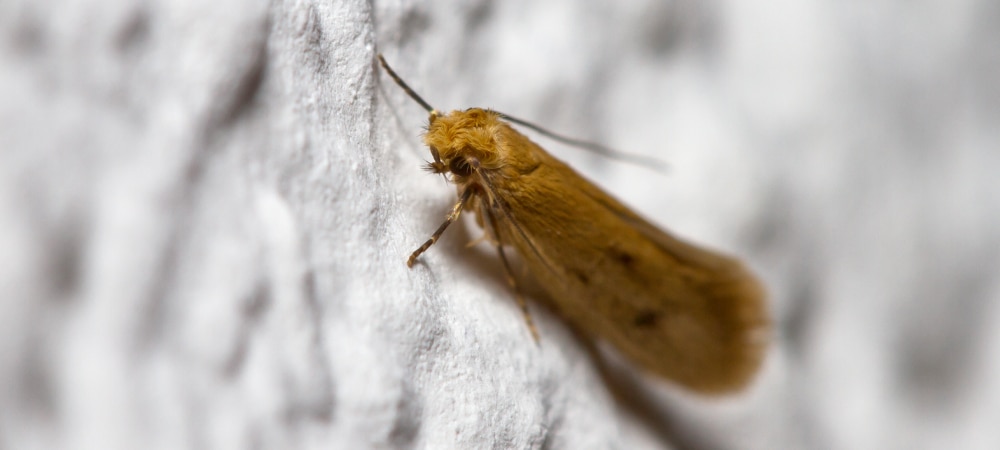
Casemaking (or casebearing) clothes moths are a type of household pest that destroys your stored clothing, like sweaters, scarves, coats, and delicate knits. While the adult casemaking clothes moths don’t eat clothing, their larvae consume a wide range of fabrics while they prepare to pupate. If you pull out your favorite fall and winter clothing only to find it riddled with small holes, you might be dealing with a casemaking clothes moth infestation. Use this guide to learn more about how to get rid of them quickly and efficiently.
What are casemaking clothes moths?
Casemaking clothes moths are a common species of fabric-destroying moth. The adults are about ¼-inch long with wings that are a deep brownish tone with dark-colored spots. Casemaking clothes moths have weak wings, meaning they typically don’t fly around homes, unlike food or grain household moths. They stay near their breeding areas and hide in dark, humid spaces, especially when feeling disrupted. While the adults won’t eat your clothing, the larvae feed on a wide variety of household fabrics.

Life cycle of casemaking clothes moths
Casemaking clothes moths lay around 40 to 50 eggs during a 2-3 week period. The female moths die once they’ve completed their egg-laying routine. However, male casemaking clothes moths outlive the females and continue to mate through multiple generations. The female’s eggs are covered in an adhesive secretion that keeps them attached to fabric threads. In the right conditions during warm weather months, the eggs hatch in 4 to 10 days.
The larvae have a wide range of molting cycles—as little as 5 days and as many as 45 days—depending on indoor conditions and available food. The casemaking clothes moth larval stage lasts anywhere from 35 days to 2 ½ years. They’re a shiny white color with dark capsule heads, and carry a permanent silken case as they move around.
When they are ready to pupate, the larvae wander from their food source to find small crevices and pupate in the case they create while eating. Pupation lasts 8 to 10 days in the summer and 3 to 4 weeks during winter. Heated buildings can accelerate their pupation process when it’s cold outside.
How to tell the difference between webbing and casemaking clothes moths
Casemaking clothes moth larvae create a silken web that they carry with them as they eat. They take their material with them as they consume fabric and use it to build their cocoon when the time comes to pupate. Casemaking clothes moth cocoons can be found in tiny crevices in dark, well-hidden spaces that aren’t frequently disturbed, such as chests, trunks, off-season closets, or stored clothing in basements or attics.
Webbing clothes moths are extremely similar to casemaking clothes moths, with many shared habits and features. However, webbing clothes moth larvae leave behind small webbed shelters, which are the same color as the fabric they’re eating. Adult moths are lighter in color and have no dark spots on their wings.
Signs of a casemaking clothes moth infestation
The most common and easily recognizable sign of a casemaking clothes moth infestation is finding small holes in your stored clothing. Items like sweaters or knit materials made from animal-based fibers like wool, alpaca, cashmere, or authentic fur are attractive to case-making clothes moths, especially when kept in dark, hidden areas. However, animal-based fibers aren’t only used in clothing, which means casemaking clothes moths can also damage household fabrics like rugs, blankets, tapestries, knitting yarns, and upholstered chairs. These items are typically only infested when placed in storage and not in daily use. You may also notice dead larvae, dead adult moths, or empty cocoons in or around the areas where they’ve been feeding.
How to get rid of casebearing clothes moths
If you’ve noticed signs of a casemaking clothes moth problem in your home, there are a few actions you can take to help control their spread and save any clothing that hasn’t already been damaged, including:
- Cleaning. General household cleaning and thorough vacuuming can remove them from your fabrics. You can also plan a seasonal airing of carpets, rugs, and any stored clothing to disrupt their setup and remove unhatched eggs or adults who haven’t mated yet.
- Dry cleaning. Try dry cleaning your stored clothing seasonally to make your clothes less appealing and remove moisture that could attract casemaking clothes moths. The process of dry cleaning can also kill existing moths on clothing.
- Freezing. Casemaking clothes moth eggs and larvae can’t survive long periods in temperatures under 32 degrees Fahrenheit. When you air out stored clothing or household fabrics, leave them in a cold temperature for several hours to kill any potential eggs or larvae.
- Hot washing. Running your fabrics through a hot-water cycle on your washing machine for at least 30 minutes may help kill hiding moths, larvae, and eggs. Make sure you check your clothing or household fabric care instructions to ensure they can withstand higher temperatures.
Pest control services
The most successful way to remove casemaking clothes moths from your home is to hire a professional pest control service such as Hawx Pest Control. We offer safe and affordable extermination for your current problems and preventative treatments to address potential threats before they happen. Our teams focus on providing friendly, knowledgeable expertise to provide the highest quality results, leading to a safer and more reliable outcome that addresses current problems and prevents future infestations.
Categories
RELATED POSTS



